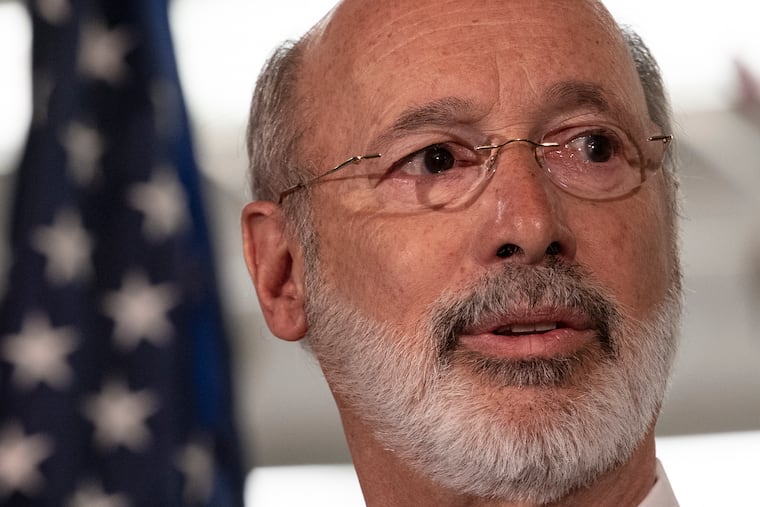Gov. Tom Wolf: Pa. should cut carbon emissions 80 percent by 2050
Part of the state's climate change strategy is for nuclear power to produce more carbon-free electricity. Gov. Tom Wolf would not say if he supports a controversial proposal for state ratepayers to compensate nuclear plants to do this.

HARRISBURG — Pennsylvania, one of the nation’s largest fossil fuel producers, on Monday became the 24th state to join the U.S. Climate Alliance, committing to work toward cutting greenhouse gas emissions in line with the Paris Agreement despite the Trump administration’s intent to quit the international climate pact.
Gov. Tom Wolf made the announcement at the same time that the state released its newest road map for combating and adapting to climate change. The 230-page document sets a goal for cutting carbon dioxide and other heat-trapping emissions 26 percent by 2025 and 80 percent by 2050, using 2005 as a baseline.
No other state in the bipartisan climate alliance produces as much natural gas, coal, and electricity as Pennsylvania, a top-three producer of each.
The new climate action plan envisions dramatic shifts toward lower-carbon methods of powering Pennsylvania’s homes, vehicles, and businesses, with a phaseout of most of the state’s coal-fired power plants by 2050.
It includes more than 100 actions that governments, businesses, and individuals can take to reduce greenhouse gas emissions.
Still, the 15 “most practical and impactful” strategies that are measured in the report would cut the state’s greenhouse gas emissions by 21 percent by 2025 and 36 percent by 2050 — falling well short of the state’s long-term goal. Those strategies include making buildings more energy-efficient, transitioning to electric vehicles, and getting more electricity from wind and solar.
“I know that change can be difficult, and that as a major energy-producing state, the challenges facing Pennsylvania in addressing this threat are indeed significant,” Wolf said during a news conference in Harrisburg.
He endorsed bills slated to be introduced in the state House and Senate that call for renewable energy sources to supply 30 percent of electricity needs by 2030. The target under current law is 8 percent by 2021.
The action plan also calls for implementing policies to keep the Three Mile Island and Beaver Valley nuclear plants from closing in 2019 and 2021, but Wolf would not say whether he supports hotly debated bills in the legislature to rescue the nuclear plants by paying them for producing carbon-free power.
Right now, Pennsylvania’s five nuclear plants generate 93 percent of the state’s carbon-free energy, dwarfing the combined contributions of wind, solar, and hydropower.
If passed, the nuclear subsidy proposals could cost electricity ratepayers $500 million a year.
“I am part of the conversations, and I will continue to be,” Wolf said.
Pennsylvania’s greenhouse gas emissions already declined 12 percent between 2005 and 2015 as energy efficiency improved and natural gas began to displace coal as a power-plant fuel.
In a letter attached to the report, six members of the state’s climate-change advisory committee who work for the coal, gas, and agriculture industries criticized the plan for not giving enough attention to the emissions reductions that the state and nation have already achieved.
They also objected to the figure that the plan uses to estimate the “social cost of carbon,” a measure of the economic harm caused by climate change.
If the plan had adopted the significantly lower social cost of carbon recommended by the Trump administration, it would have undermined the cost-benefit calculation of “most if not all of the recommendations” in the plan, they wrote.
The report’s economic analysis found that, together, the 15 measured strategies would have a positive effect — increasing disposable personal income and gross state product and creating about 40,000 jobs by 2050.
The report also paints a dire picture of a warmer planet in which “extreme weather and catastrophic natural disasters” are already becoming more frequent and intense.
Laura Legere: llegere@post-gazette.com.